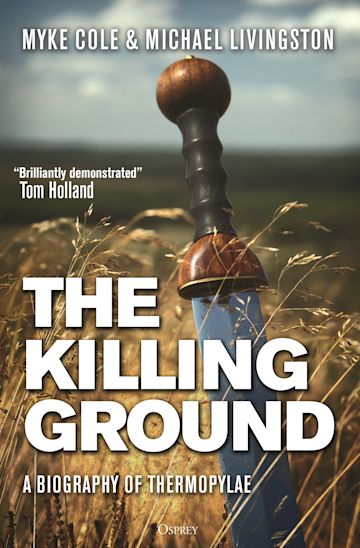The Killing Ground: A Biography of Thermopylae
- By Myke Cole and Michael Livingston
- Osprey Publishing
- 304 pp.
- Reviewed by Peggy Kurkowski
- February 23, 2024
A fascinating history of the storied Greek battlefield.

The legendary Battle of Thermopylae in 480 BC between Leonidas’ “300 Spartans” and Xerxes’ invading Persian armies is well known (and equally misunderstood), but it was not the final conflagration the “Hot Gates” would host. Indeed, Thermopylae played a pivotal role for both invading and defending forces for more than two millennia, according to military historians Myke Cole and Michael Livingston in their impressive new study, The Killing Ground.
Setting their investigational goal posts wide, the authors explore 27 independent battles and holding actions at Thermopylae over the course of 2,500 years. Moving from the renowned encounters between Greeks and Persians, Cole and Livingston catalog a series of clashes along this rugged strip of Greece’s Malian Gulf coast that includes Romans, Gauls, Goths, Byzantines, Huns, Ottomans, and even World War II battles between Germans and Allied forces.
Why such slaughter in such a small geographical area roughly “a square 10 miles on a side” and bracketed with near impassable mountains? The authors begin with a detailed geological primer on the landscape of Thermopylae, a product of eons of geomorphological movement and subduction that created Mount Kallidromo to the south, Mount Oiti to the west, and the Malian Gulf to the east. Together, they comprise the Oiti-Kallidromo barrier, a “daunting line of rock” within the broader Pindus Range that splits Greece in half. To invade central Greece, armies had to contend with this natural divider, the critical choke points of Thermopylae and the Oiti Pass functioning as the doors “that must be opened to step into the courtyard beyond.”
In the larger geopolitical context, Thermopylae was “a polestar for battle” because of Greece’s position relative to imperial powers of the Mediterranean world: The peninsula is centrally located along major trade routes, and Thermopylae was “the center of the center.” As much a history of the land as of the fighting done upon it, The Killing Ground includes helpful maps; a bird’s-eye view of the Oiti-Kallidromo barrier overlaid with color-coded ancient and modern paths is particularly revealing.
When it comes to the battles themselves, at least a third of the book explores the conflict between Leonidas and Xerxes — popularized in the movie “300” — which is to be expected. The myth that such a small number of Spartans defended the pass at Thermopylae is just that, of course; the authors estimate more than 8,000 men were sent to its defense.
Cole and Livingston propose bold new theories about the battle that should stir debate in military-history circles, writing that “the Greek plan at Thermopylae is widely misunderstood.” They contradict Greek historian Herodotus’ assertion that Leonidas and the Spartans marched off knowingly to martyrdom to fulfill a highly suspect pronouncement of the Oracle at Delphi. Provocatively, they claim that “one thing we can be certain Leonidas was not doing was planning to die.” This section of The Killing Ground fearlessly engages with primary source material, archaeological evidence, and boots-on-the-ground inspection of the terrain to demonstrate persuasively how the battle unfolded (and alone is worth the price of the book).
As history advances, so too does geography. For example, in their account of “the Fifth Battle of Thermopylae” in 279 BC, the authors document the silting up of the Malian Gulf along the eastern coastline of Thermopylae, which impacted the Greeks’ ability to rain arrows from their ships to support land forces battling the invading Gauls:
“We know that in 480 BC, the waters of the Gulf were deep enough close to shore to moor a fairly large ship there. But in 279 BC, the mud extended far enough out into the water that the Athenian ships struggled to get close enough to provide missile support to the Greeks fighting in the pass.”
Each “Battle of Thermopylae” represented varies in length and detail based on the availability of extant sources. Cole and Livingston admit — readily and repeatedly — where the historical record is silent on events and how they unfolded. In these instances, they doggedly pursue “the glimmer in the darkness of our lack of sources,” but the reader may grow frustrated at the increasingly fragmentary nature of the oldest battle narratives (although it’s no fault of the authors).
In The Killing Ground, Cole and Livingston have given us a vigorous and engaging reexamination of “the most blood-soaked ground in the world” that will thrill ancient- and military-history fans alike.
Peggy Kurkowski is a professional copywriter for a higher-education IT nonprofit association by day and major history nerd at night. She writes for multiple book review publications, including Publishers Weekly, Library Journal, BookBrowse Review, Historical Novels Review, Independent Book Review, Shelf Awareness, and the Independent. She hosts her own YouTube channel, “The History Shelf,” where she features and reviews history books (new and old), as well as a variety of fiction. She lives in Colorado with her partner (quite possibly the funniest Irish woman alive) and four adorable, ridiculous dogs.

